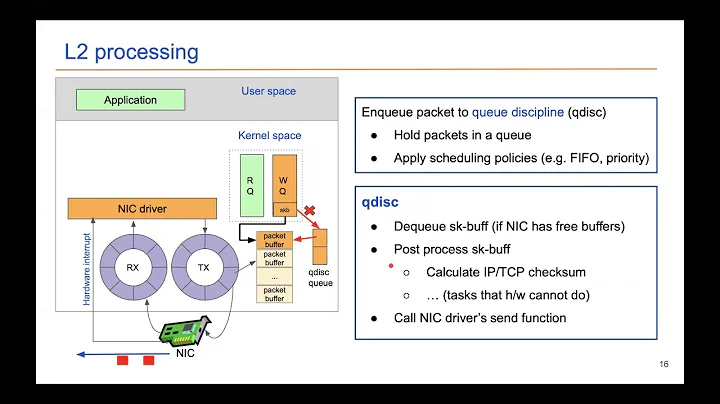Kernel socket structure and TCP_DIAG
Solution 1
sk_forward_alloc is the forward allocated memory which is the total memory currently available in the socket's quota.
sk_wmem_queued is the amount of memory used by the socket send buffer queued in the transmit queue and are either not yet sent out or not yet acknowledged.
You can learn more about TCP Memory Management in chapter 9 of TCP/IP Architecture, Design and Implementation in Linux By Sameer Seth, M. Ajaykumar Venkatesulu
Solution 2
See the man page of ss.
<fwd_alloc>
The memory allocated by the socket as cache, but not used for receiving/sending packet yet. If need memory to send/receive packet, the memory in this cache will be used before allocate additional memory.
<wmem_queued>
The memory allocated for sending packet (which has not been sent to layer 3)
Solution 3
Regarding sk_wmem_queued and sk_wmem_alloc, I asked the same question so I'll copy the answer here:
I emailed Eric Dumazet, who contributes to the Linux network stack, and here is the answer:
sk_wmem_alloctracks the number of bytes for skb queued after transport stack : qdisc layer and NIC TX ring buffers.If you have 1 MB of data sitting in TCP write queue, not yet sent (cwnd limit),
sk_wmem_queuewill be about 1MB, butsk_wmem_allocwill be about 0
A very good document for understanding what these three types of queues (socket buffer, qdisc queue and device queue) are is this article (rather long) article. In a nutshell, the socket starts by pushing the packets directly onto the qdisc queue, which forwards them to the device queue. When the qdisc queue is full, the socket starts buffering the data in its own write queue.
the network stack places packets directly into the queueing discipline or else pushes back on the upper layers (eg socket buffer) if the queue is full
So basically: sk_wmem_queues is the memory used by the socket buffer (sock.sk_write_queue) while sk_wmem_alloc is the memory used by the packets in the qdisc and device queues.
Related videos on Youtube
Twister
French Java Developer. Currently working at Société Générale Corporate & Investment Banking
Updated on September 18, 2022Comments
-
Twister over 1 year
I'm working on a software which connects to a Real Time data server (using TCP) and I have some connections dropping. My guess is that the clients do not read the data coming from the server fast enough. Therefore I would like to monitor my TCP sockets. For this I found the "ss" tool.
This tool allows to see the state of every socket - here's an example line of the output of the command
ss -inm 'src *:50000'ESTAB 0 0 184.7.60.2:50000 184.92.35.104:1105 mem:(r0,w0,f0,t0) sack rto:204 rtt:1.875/0.75 ato:40My question is: what does the memory part mean? Looking at the source code of the tool I found that the data is coming from a kernel structure (
sockinsock.h). More precisely, it comes from the fields :r = sk->sk_rmem_alloc w = sk->sk_wmem_queued; f = sk->sk_forward_alloc; t = sk->sk_wmem_alloc;Does somebody know what they mean? My guesses are:
rmem_alloc: size of the inbound bufferwmem_alloc: size of the outbound buffersk_forward_alloc: ???sk->sk_wmem_queued: ???
Here are my buffers sizes :
net.ipv4.tcp_rmem = 4096 87380 174760 net.ipv4.tcp_wmem = 4096 16384 131072 net.ipv4.tcp_mem = 786432 1048576 1572864 net.core.rmem_default = 110592 net.core.wmem_default = 110592 net.core.rmem_max = 1048576 net.core.wmem_max = 131071 -
little-dude over 4 yearsI don't understand how this definition of
sk_wmem_queueddiffers fromsk_wmem_alloc, could you expand a little on this? (If you know the answer, feel free to add an answer to this question: unix.stackexchange.com/questions/551444/…) -
milosgajdos over 3 yearsIt this
bytesorpages?




